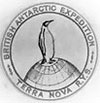Three glaciers
December 1st, 2002
We took the Polaris ATV across the lake ice to the Bonney Rigel, a peninsula of hills that nearly cuts Lake Bonney into two pieces, one larger, one smaller.
It took about thirty minutes to get to the end of the lake. There we reached the Taylor and Rhone glaciers.
The Taylor glacier is a moving slab of ice the size of Erie, Pennsylvannia. It's deeply crevassed, and about fifty feet tall from base to summit. There are dark tree ring like striations in the ice when viewed from the side. Glaciologists tell me these denote periods of deep snows interspersed with dry windy times where dust was deposited.
The face of Taylor glacier is red with iron oxide. That's rust to you and me. No one knows why rust is leaking from the face of the glacier. But the reddish feature is large enough to warrant its own name. Blood Falls.
One climbs a small dirt mound to reach Blood Falls. There, you can touch the glacier face, or stick your head in an opening that leads to a vast lake within the glacier that's liquid in the summer.
After examining Blood Falls, we proceeded around the glacier. We stopped and munched some gorp at a large rock beside the ice even though we'd hardly been hiking enough to warrant an energy recharge. Liquid water was running off the sides and formed a babbling stream that passed below the surface ice.
I had been to this spot last year. It is such a remote, improbably distant location it had never occurred to me I might visit it again.
It's weird being familar with a place like that. It's one thing remembering where your favorite store is in the shopping mall, quite another to know there's a large rock around on the other side of the moraine.
After a surreal, leisurly stay at the Taylor, we walked across the valley to the Rhone glacier. While the Taylor glacier is a tall structure of magnificent blue ice, in comparison, the Rhone looks like a creature derived from a Dean Koontz novel. Its grayish green and full of dirt It's face is a toothed cathedral of stalagtite-like icicles.
Later that day we visited the Hughes glacier, just above camp. Lots of big blue ice here too.
In camp we harvest the blue ice for water. Drinking. Washing. Cooking. All water comes from the ice. I put Tang or Raro in it. We make tea with it. Coffee.
As the human body is 98% water, living in the field in Antarctica is a process of becoming the ice. Scientists and mountaineers joke about becoming "one" with the ice, but the truth is, after a couple of weeks, 98% of you is what you see in those glaciers.
Right now--the weather is beginning to get worse. Helo ops has just informed us all flights have been suspended. That means the guest we were expecting won't come today, and Bob, the writer who's with us, can't leave.
We ran down all our battery power getting all the computers on the net at once. Now we're running a 5KW generator to recharge everything before conditions deteriorate to the point we can't leave the jamesway.
Are we having an adventure? Or what?
